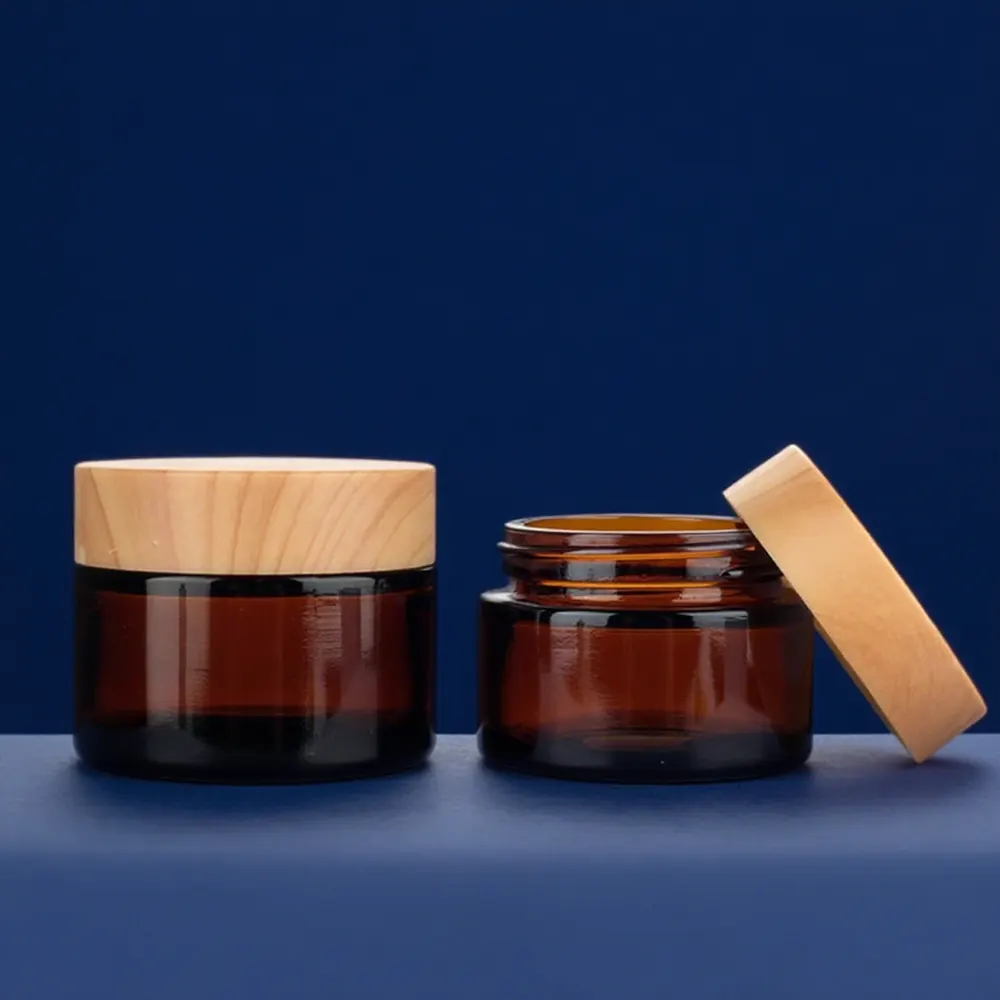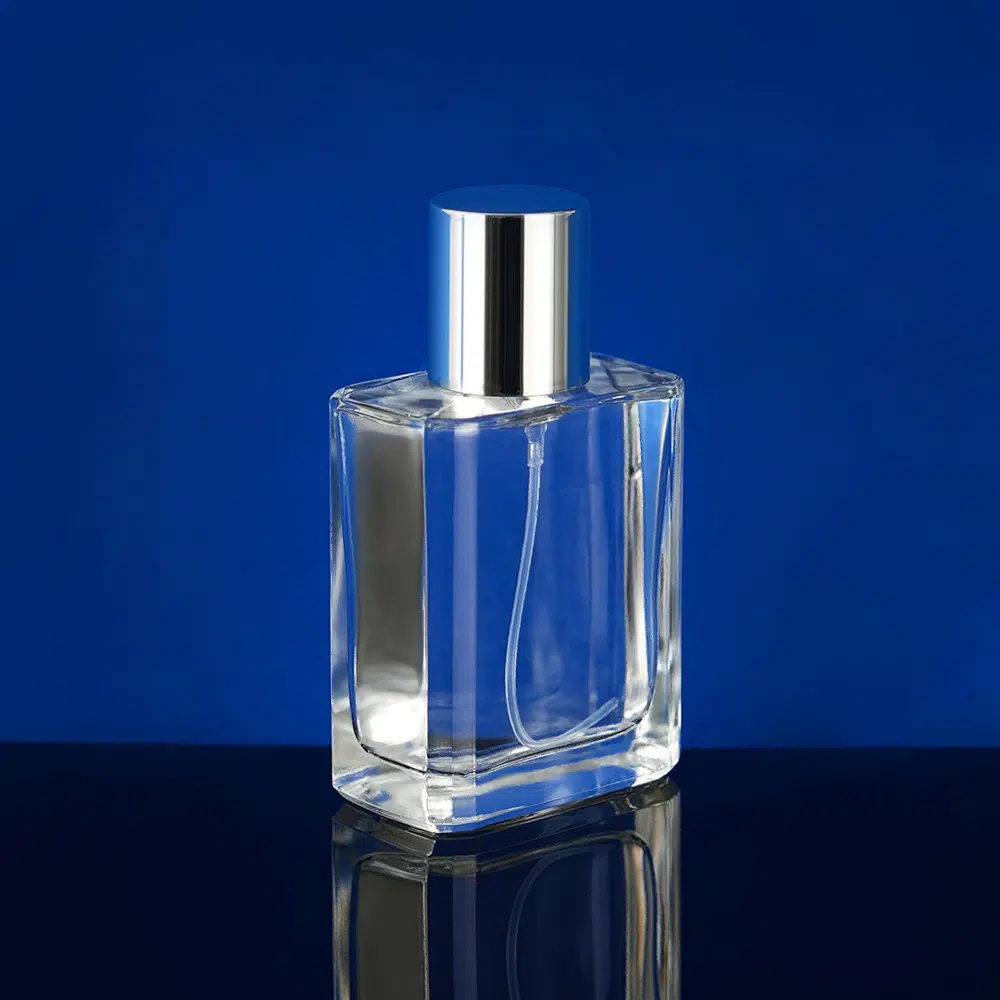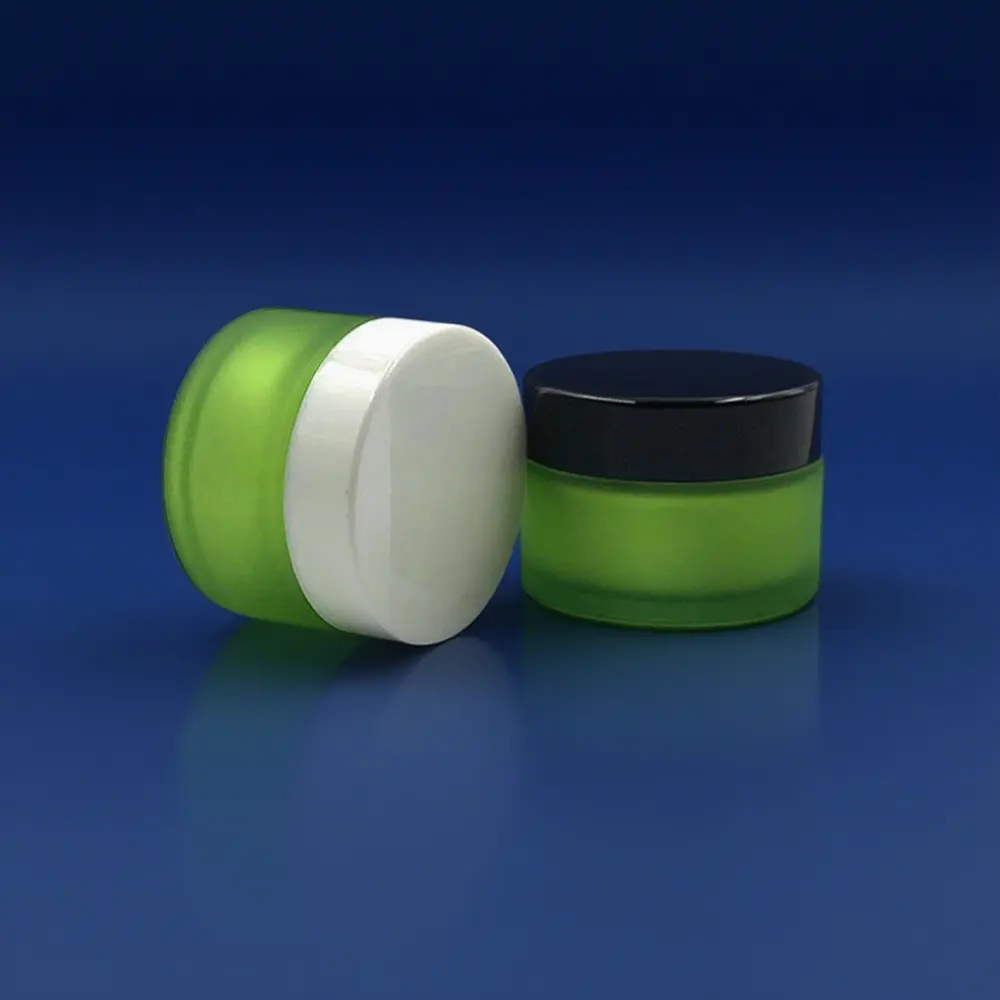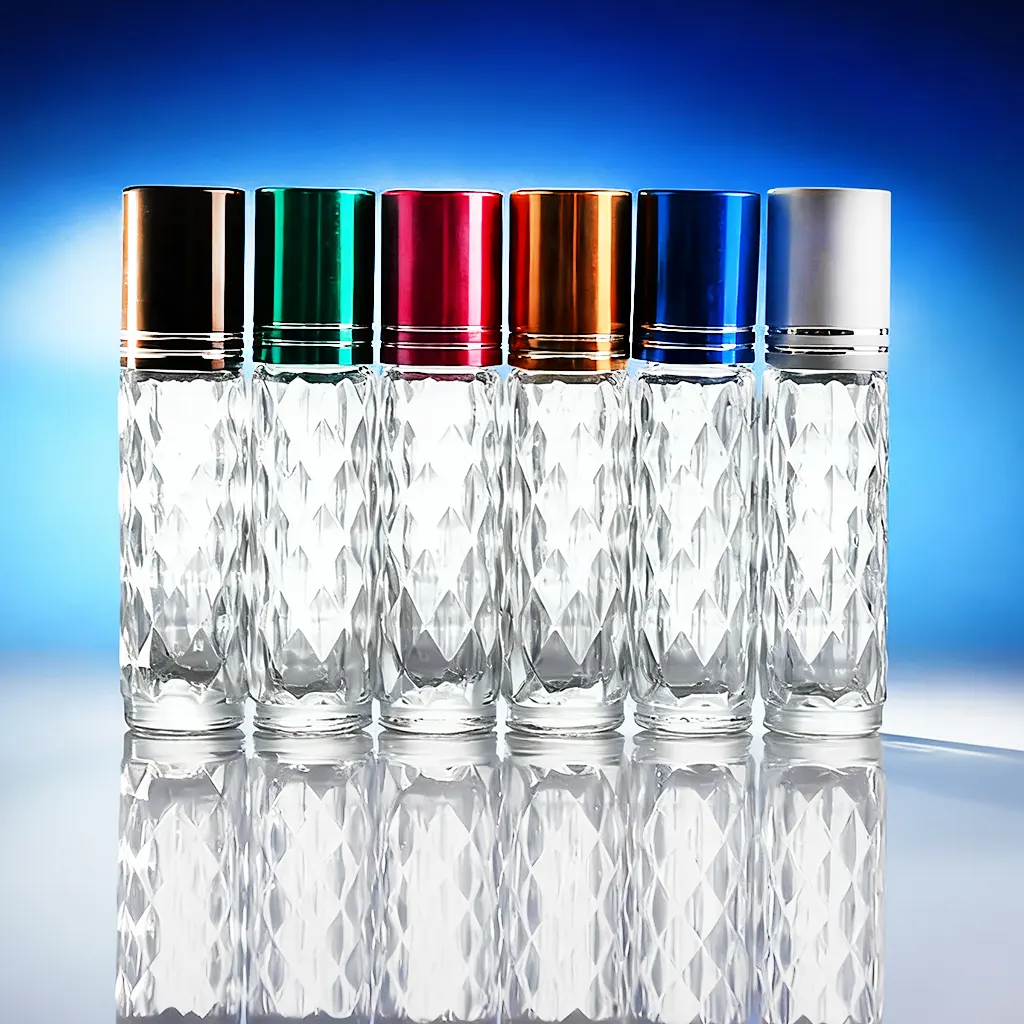
유리 에센셜 오일 병 성공에 있어서 화장품 포장 회사의 필수적인 역할
목차
1. 서론: 유리 에센셜 오일 병 출시를 위한 포장 회사의 전략적 필수성
급속한 에센셜 오일 시장에서 화장품 포장재 기업들은 성공적인 제품 출시, 특히 유리 에센셜 오일 병의 경우 중요한 전략적 파트너입니다. 본 보고서는 화장품 포장재 기업들이 고유한 과제와 기회를 해결하며 다재다능하게 기여하고 있음을 강조합니다. 글로벌 에센셜 오일 시장이 크게 성장할 것으로 예상(2030년~2034년 270억~590억 달러)하는 가운데, 포장은 성장, 차별화, 그리고 시장 성공을 위한 중요한 도구가 되며, 첫인상과 브랜드 스토리를 담는 캔버스 역할을 합니다. 다음과 같은 브랜드의 경우, 베셀럭스경쟁이 치열한 시장에서는 프리미엄 포장이 가장 중요합니다.
2. 컨셉 및 디자인: 브랜드 비전을 기능성 유리 에센셜 오일 병으로 구현
제품 여행은 협업적 컨셉과 디자인으로 시작하여 브랜드의 정체성을 기능적이고 미적으로 만족스러운 것으로 전환합니다. 유리 에센셜 오일 병.
2.1. 제품 효능 및 브랜드 포지셔닝을 위한 재료 선택
유리는 에센셜 오일의 화학적 불활성화로 인해 필수적이며, 반응을 방지하고 침출, 순도, 강도 및 유통기한을 보존합니다.
- 앰버 유리: 업계 표준에 따라 자외선을 97% 이상 차단하며, 빛에 민감한 오일에 이상적입니다.
- 코발트 블루와 그린 유리: 적당한 자외선 차단 기능과 미적 매력을 제공합니다.
- 바이올렛 유리(미론 유리): 보라색을 제외한 모든 가시광선을 차단하여 보호력이 뛰어나며, 매우 민감한 오일에 적합하며, 초고급 제품이지만 가격이 비쌉니다.
- 붕규산 유리: 13~15%의 산화붕소는 더 나은 내열성, 내화학성, 내열충격성을 제공하여 까다로운 용도에 이상적입니다.
- 소다석회 유리: 더 저렴하고 망고(90%가 상업용 유리)이지만 내구성이 떨어집니다.
2.2. 인체공학적 디자인 및 분사 메커니즘
인체공학적 디자인으로 그립감이 좋고 붓기가 편리하여 사용자의 편의성을 높여줍니다.
- 드롭퍼 인서트: 정확한 분배에 중요합니다. 무질서로 인해 확산과 오염이 발생할 수 있습니다.
- 특정 목: 18DIN 병입형과 같은 설계는 정확한 캡 결합, 일관된 분배 및 누출을 보장합니다.
- 병 크기: 휴대성과 산화 방지를 위해 작은 크기(5ml-30ml)가 선호되며, 롤러볼이나 유로 드로퍼 탑을 사용하는 경우가 많습니다.
2.3. 클로저 무결성 및 변조 방지
오일을 보존하고 누출을 방지하려면 캡이 중요한데, 균열이 생기면 산화가 가속화되기 때문입니다.
- 변조된 밴드: 제품 안전, 소비자 사기 방지, 브랜드 평판 보호를 위해 필요합니다.
- 채우기 과정: 충전 중에 캡이 제대로 맞지 않거나 문제(예: 오일, 나사산의 토크 오류)가 발생하면 누출, 오작동 및 효능 손실, 견고한 설계 및 제조가 강조될 수 있습니다.
2.4. 브랜드 아이덴티티와 소비자 인식
포장은 브랜드 홍보대사 역할을 하며 소비자의 인식과 구매 결정에 상당한 영향을 미칩니다. 소비자의 66%는 포장을 기준으로 신제품을 시도해 봅니다.
- 시각적 매력: 4.1. Precision Molding Techniques
- 브랜드 정렬: 브랜드 이미지와 어울리는 포장은 진정성을 강화하는 동시에, 색상, 상상력, 그리고 타이포그래피는 감성적 관계를 자극합니다. 친환경 포장은 안정성을 상징합니다.
- 문화적 미학: 4.3. Diverse Decoration Methods
2.5. 협업 및 고급 시각화 도구
효과적인 협력을 위해서는 브랜드 정체성과 타겟 고객을 이해하는 것이 필요합니다.
- 신속한 프로토타입: 3D 렌더링과 AI 관련 벡터는 필수적인 요소입니다. Jarsking과 같은 회사는 신속한 프로토타입 제작 및 디자인 반복을 위해 3D 도면을 활용하여 몇 시간 만에 디자인을 개발하고 며칠 만에 샘플을 개발합니다.
- 도전 극복: 이러한 장치는 정확한 재료 공급과 금형 수정을 통해 유기적 모양의 기본 안정성을 보장하는 데 도움이 됩니다.
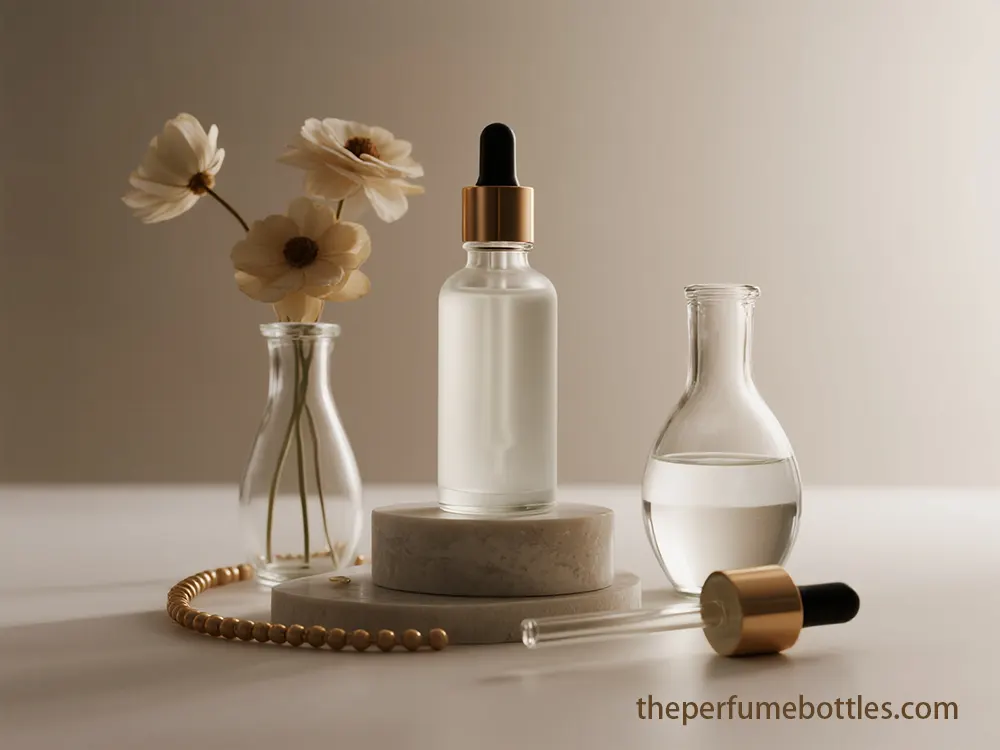
무료 샘플 받기
3. 유리 에센셜 오일 포장 기술 개발 및 프로토타입 제작
엔지니어링 및 검증 제품은 무결성, 보안 및 유효 기간을 보장합니다.
3.1. 화학적 호환성 및 자외선 차단
유리는 화학적 관성이 뛰어나 플라스틱과 고무를 분해하는 휘발성 화합물과의 상호작용을 방지하여 선호됩니다. 플라스틱 병은 화학 물질을 녹이고, 오일의 품질을 변화시키며, 위험을 증가시킬 수 있습니다. 많은 에센셜 오일은 빛에 민감합니다. 어두운 유리(호박색, 코발트 블루, 녹색)는 유해한 자외선을 차단하고, 유통기한을 늘리며, 치료 효과를 유지합니다.
3.2. 구조적 건전성 테스트
엄격한 테스트를 통해 신체적 유연성을 보장합니다.
- 열충격 저항성: 병이 붕괴되지 않고 급격한 온도 변화(예: 60~90°C에서 0~20°C)를 어떻게 견뎌내는지 평가하며, 운송 및 보관에 중요합니다. 64, ASTM C149는 특히 상업용 유리 용기를 열 충격에 대해 테스트합니다.
- 낙하 및 압력 저항성: 병은 물리적 효과와 내부 압력을 보장합니다.
3.3. 고급 설계 및 시뮬레이션 도구
- 신속한 프로토타입: 3D 프린팅(SLA, FFF)은 디자인 개발을 가속화하여 생산, 예산 조정 및 출시 전에 미적 및 구조적 평가를 가능하게 합니다.
- 터미널 요소 분석(FEA): 안정적이고 일시적인 하중(내부 압력, 열 충격)으로 인한 유리 설계의 응력을 파악하고, 제조 전에 문제가 있는 영역을 식별하여 빛이나 성능에 맞게 설계를 조정합니다.
3.4. 새로운 폐쇄 시스템에 대한 검증 프로세스
밀폐 시스템은 공기 위험과 오염으로부터 보호하기 위해 기밀 밀봉에 중요합니다. 밀폐형 부품이나 부적절한 충전은 누출 및 오작동을 유발할 수 있습니다. 18DIN 캡과 넥 에센셜 오일은 드로퍼 병의 산업 표준입니다.
3.5. 산업 표준 및 화학적 특성
- ISO 및 ASTM 표준: 유리 재료 시험 및 교정 방법을 설정하고, 품질과 허용 오차 범위를 확보하십시오. ASTM은 미국(제약품 분야 FDA-Panchayat)에서 널리 사용되는 반면, ISO는 유럽과 아시아에서 널리 사용됩니다.
- 에센셜 오일 화학적 특성 분석 특성: 가스크로마토그래피-질량분석법(GC-MS)은 성분을 식별하고, 농도를 측정하고, 진위 여부를 확인하고, 변조 여부를 감지하여 의학적 이점과 규정 준수를 보장합니다.
3.6. 포괄적인 패키징 검증
포장 검증에는 합격 기준, 충분한 샘플 크기, 그리고 최악의 위치 선정을 포함한 완전한 계획이 필요합니다. 전략은 ISO 11607-1, -2 및 ISO와 같은 표준, 특히 멸균 장벽 설계와 부합해야 합니다. 용기 마개 시스템에는 아징(Aajing) 연구와 추출물/레셸(Lechelles) 시험 또한 중요합니다.
4. 유리 에센셜 오일 병 제조 및 품질 보증
고품질 유리 에센셜 오일 병 첨단 제조, 정확한 장식, 엄격한 품질 관리에 의존합니다.
4.1. 정밀 성형 기술
병은 블로우-블로우, 프레스-블로우, 협목 프레스-블로우(NNPB)와 같은 첨단 성형 기술을 사용하여 생산되며, 이를 통해 정밀한 유리 분배와 더 가볍고 튼튼한 용기가 가능해졌습니다.
4.2. 임계 어닐링 공정
성형 후, 병은 바타(bhatta)의 터널을 통과하여 급속 냉각을 통해 내부 응력을 제거하는데, 이는 강도와 내구성을 크게 향상시킵니다. 소다석회 유리의 경우, 병을 510~550°C로 가열한 후 20분에서 2시간 동안 서서히 냉각합니다. 적절한 어닐링은 내충격성을 300%까지 증가시킬 수 있으며, 50~70°C의 온도 변화에도 견딜 수 있습니다.
4.3. 다양한 장식 방법
적응은 매력과 브랜딩을 통해 아름다움을 향상시킵니다.
- 실크스크린 인쇄, 핫포일 스탬핑, 레이저 조각, 섬세한 응용, 스프레이 페인팅, 프로스팅, 전기 도금, 패드 인쇄, 금속화, 핫 전사 및 마카시.
4.4. 다단계 품질 관리 프로토콜
엄격하고 여러 단계로 구성된 QC 프로토콜이 적용됩니다.
- 원자재 검사: 순도, 성분, 수분을 확인합니다.
- 진행 중 모니터링: 온도, 대칭성 및 곰팡이의 지속적인 모니터링.
- 생산 후 검사: 치수 정확도, 시각적 결함(기포, 균열, 긁힘) 및 기능 테스트(효과, 압력, 열충격, 밀봉, 내화학성)에 대한 100% 수동 및 자동 검사.
4.5. 고급 자동 검사 시스템
자동 시스템은 고속 정밀 결함 감지에 필수적입니다. 고해상도 카메라, 특수 센서, LED 조명, 그리고 AI/머신러닝 알고리즘을 활용하여 최대 0.1mm의 정확도로 미세 결함(미세 교차, 기포, 변형, 실 고)을 식별합니다.
4.6. 지속적인 개선을 위한 통계적 공정 관리(SPC)
SPC는 실시간 데이터를 활용하여 건설 공정을 모니터링하고 제어하여 효율성과 일관된 품질을 보장합니다. SPC는 관리도를 관리하여 발생 가능한 원인에 따른 전반적인 변동을 구분하고, 초기 문제를 감지하며, 낭비를 줄이고, 공정 역량을 향상시킵니다.
4.7. 제조 허용 오차가 하류 작업에 미치는 영향
치수 정확도는 라인 효율성과 소비자 경험에 영향을 미칩니다. 선택적 편차는 디스펜서 호환성에 영향을 미쳐 누출이나 부적절한 밀봉으로 이어질 수 있습니다.
4.8. 에너지 효율 이니셔티브
제조업체는 에너지 소비와 배출량을 줄입니다.
- 용광로를 업그레이드하고, 폐열 회수를 적용하고, 물과 전기 사용을 최적화합니다.
- 용융 온도와 에너지 필요성을 줄이는 컬릿 컬릿(배치 혼합물의 25~90%)을 사용합니다.
- 가벼운 병 디자인은 용융 및 형성 과정에서 에너지를 절감합니다.
4.9. 장식 유리의 색상 일관성 문제
대량 생산, 특히 스프레이 코팅이나 스크린 인쇄에서 연속적인 색상을 유지하는 것은 쉽지 않습니다. 잉크/페인트 배치 종류, 도포 두께, 처리 등의 요인이 최종 색상에 영향을 미치므로 엄격한 공정 모니터링이 필요합니다.
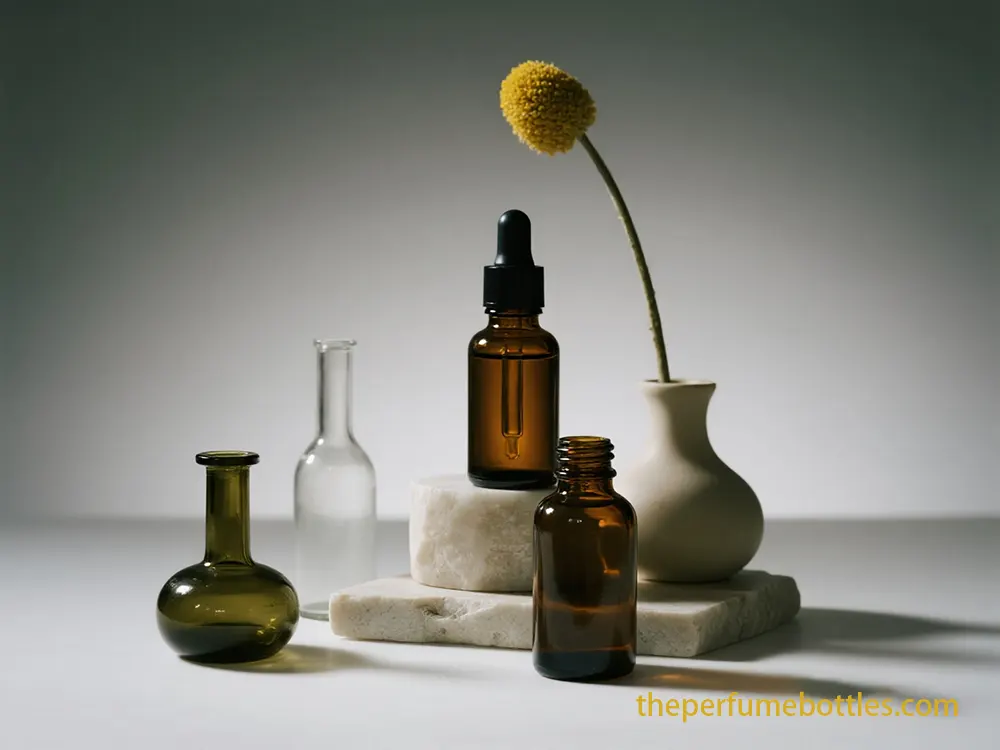
무료 샘플 받기
5. 유리 에센셜 오일 포장을 위한 공급망 관리 및 물류
섬세한 유리 에센셜 오일 병의 공급망을 조정하는 것은 효율성, 비용 효율성 및 시장 책임성을 위해 중요합니다.
5.1. 소싱 최적화
- 재료 선택: 소다석회, 붕규산 또는 유색 유리(호박색, 코발트색, 녹색)는 주로 화학적 불활성화 및 자외선 차단에 사용됩니다. 보라색 유리는 초극세사 제품에 더 나은 보호 효과를 제공합니다.
- 비용 구조 및 공급업체 선택: 총 양륙 비용에는 원자재(규사, 소다회, 석회석, 콜라렛)가 포함되며, 원자재의 불안정성은 가격에 영향을 미칩니다. B2B 구매자는 품질 관리(ISO, GMP), 적응성, 최소 주문 수량(mOQ)(맞춤형 제품의 경우 5,000~10,000개), 리드타임 및 샘플 제공을 기준으로 제조업체를 평가합니다. 특히 중국과 같은 허브를 구축하는 경우 장기적인 협력 관계를 통해 품질 보증이 보장됩니다.
- 특정 구성 요소 및 닫힘: 정확한 드로퍼, 오르피스 리듀서, 변조 방지 및 어린이 보호 캡을 포함하여 누출, 오염, 낙하 및 우발적 섭취를 방지하는 무결성과 안전성이 중요합니다.
Rising consumer demand:
- 보호 포장: 다층 포장 전략은 파손을 줄입니다. 개별 포장(버블랩, 폼 슬리브), 쿠션 패드, 맞춤 성형 삽입물(예: EPS, 손실률 37% 감소), 펄프 성형 섬유 또는 골판지 칸막이 등을 사용합니다. 땅콩, 에어쿠션 또는 크럼포트 포장재로 빈 공간을 채우는 것이 중요합니다. 또한 이중 포장과 취약 부분을 강화하는 것도 중요합니다.
- 창고: 건조하고 안정적이며 온도/습도가 조절되는 환경에 보관된 병은 유리의 팽창/수축을 방지하고 포장을 보호합니다. 전략적으로 쌓아 올리는 방식(팔라타이징, 인터로킹)은 안정성을 높입니다. 빛에 민감한 오일은 직사광선으로부터 보호하는 것이 필수적입니다.
- 수송: 진동을 줄이려면 급격한 변속과 온도 조절이 가능한 차량이 필요하며, 에어 라이딩 서스펜션을 방지해야 합니다. 해당 품목은 스트랩, 적재함 바 또는 에어백으로 고정해야 합니다. 무게를 고르게 분산하고 "섬세한" 라벨을 명확하게 표시하는 것이 중요합니다.
5.3. 글로벌 공급망을 위한 위험 완화 전략
- 다각화와 과잉: 중요 부품에 대한 이중 또는 다중 소싱 단일 공급업체 의존도를 줄이고, 지정학적 갈등, 자연재해 또는 노동 문제로 인한 위험을 줄입니다. 물류 전달/재공급은 위험과 리드타임을 줄일 수 있습니다. 장기 계약 및 예비 재고 또한 중요합니다.
- 적극적 모니터링 및 임시 계획: 지속적인 위험 평가, 공급업체 성과(재정 안정성, 품질, 사업 연속성) 모니터링, 그리고 임시 계획 수립이 필수적입니다. 경관 계획 및 미래 분석을 위한 AI 기반 장비는 위험을 예측하고 신속한 대응을 가능하게 합니다.
5.4. 공급망 가시성 플랫폼의 역할
- 사물인터넷과 디지털화: 이 플랫폼은 IoT 센서, RFID 태그, 바코드 시스템을 사용하여 실시간 종단 간 투명성을 확보합니다. IoT 장치는 화물의 위치(온도, 습도, 충격, 진동)를 모니터링하고 GPS 추적 기능을 제공합니다. 이 데이터는 능동적인 의사결정을 가능하게 하고, 장애물을 식별하며, 즉각적인 검사 및 클레임 처리를 가능하게 합니다.
- 블록체인: 필수 오일의 무결성과 규정 준수에 중요한 돌이킬 수 없는 기록, 확장된 추적성, 신뢰할 수 있는 거래를 검색합니다.
5.5. 운송 방법의 비용-편익 분석(추측/예측)
해상 운송은 부피가 크고 시간이 많이 소요됩니다. 항공 운송은 신속한 배송이 가능하지만, 특히 온도 관리 및 깨지기 쉬운 유리를 위한 견고한 보호 포장이 필요하므로 비용이 많이 듭니다. 항공 운송은 비용 효율성, 시장 출시 속도, 그리고 고장/환경 변동의 위험을 균형 있게 고려한 운송 방식입니다. 고가이거나 시간에 민감한 석유 제품은 항공 운송이 타당할 수 있습니다.
5.6. 지정학적 사건이 유리 공급망에 미치는 영향
지구물리학적 사건(무역전쟁, 관세, 갈등, 규제)은 유리 공급망에 큰 영향을 미치고, 원자재 가격을 상승시켜 생산 차질을 초래하며, 공급업체 다각화를 요구합니다. 예를 들어, 고온으로 인한 정전은 공급망 가시성 확보와 대체 공급업체의 필요성을 부각시킵니다.
6. 유리 에센셜 오일 포장의 규정 준수 및 지속 가능성
포장 회사는 복잡한 규칙을 탐색하고 지속 가능한 관행을 통합하는 데 상당한 도움을 제공합니다.
6.1. 규정 준수
- FDA 규정 개발(2024): 업데이트된 라벨의 명확성(표준화된 글꼴, 경고 기호 없이는 의학적 주장 없음, INCI 명명법, FDA 승인)이 어린이 보호 포장용 집중 오일(예: 에스빌리온, 페퍼민트, 티트리 오일)로 확장되었으며, 안전을 위한 재료 안전도 강화되었습니다.
- CPSC 및 아동 보호 포장(PPPA): 미국 CPSC는 PPPA를 적용하며, 이 법은 일부 에센셜 오일을 포함한 위험한 가정용 제품에 대해 어린이 보호 포장을 의무화합니다. 운송용이 아닌 제품에 대한 리콜도 시행되고 있습니다.
- 연방 위험 물질법(FHSA) 라벨링: FHSA는 위험한 에센셜 오일에 대한 특정 라벨링을 시행하고 있으며, 여기에는 수입자/제조업체 세부 정보, 일반/화학명, 신호 용어("위험", "주의"), 위험/예방 문구, 응급 처치 지침 및 "손이 닿지 않는 곳에 보관"이 필요합니다.
- 재료 안전 및 자외선 보안: 유리는 비활성으로 화학 반응과 침출을 방지하여 선호됩니다. 앰버 유리와 코발트 유리는 자외선 차단 기능을 제공하며, 앰버 유리는 더 나은 부식 방지 기능을 제공합니다.
6.2. 유리 에센셜 오일 포장의 지속 가능성
- 소비자 후 재활용(PCR) 유리: 유리는 영구적으로 재활용됩니다. PCR 유리를 사용하면 (상당히) 원자재를 절약하고 에너지를 절감할 수 있습니다(쿨렛 10% 증가 시 2.5%). 하지만 고품질 식품 등급 PCR의 제한, 재료의 품질 불균일, 높은 비용 등의 어려움이 있습니다.
- 가벼운 혁신: 산업은 통합을 유지하면서 병의 질량을 유지하면서 상당한 진전을 이루었습니다.
6.3. 인증 및 지속가능성에 대한 소비자 수요
- 인증 인증: 엄격하고 과학에 기반한 표준 평가로, 재료 건강, 제품 순환, 깨끗한 공기/기후 보호, 수질/토양 납, 그리고 사회적 공정성을 포함합니다. 2030년까지 모든 포장재에 대한 유럽 연합의 목표와 일치합니다.
- B Corp 인증: 사회적 및 환경적 성과는 높은 수준의 책임성과 투명성을 반영합니다. Sustainable Packaging Industries(SPI)와 JBM Packaging과 같은 기업들은 B Corp 인증을 획득했습니다.
- 증가하는 소비자 수요: 소비자의 90%는 영구 포장 브랜드를 구매할 가능성이 더 높으며, 54%는 이러한 제품을 의식적으로 구매합니다. 2025년까지 7명 중 10명은 포장을 변경할 것으로 예상되며, 43%는 추가 비용을 지불할 의향이 있습니다. 라벨의 안정성이 뛰어나다는 것은 라벨에 대한 강한 선호도(70%)를 나타냅니다.
- 확장된 제조업체 책임(EPR) 법: 새로운 EPR(환경부하청구제) 법은 포장재 제조업체의 재질 및 규정 준수 투명성 요구를 강화하여 포장재 종류, 중량, 재활용 소재에 대한 세부적인 데이터를 요구합니다. 자세한 자료를 제공하는 제조업체는 경쟁력 있는 혜택을 누릴 수 있습니다.
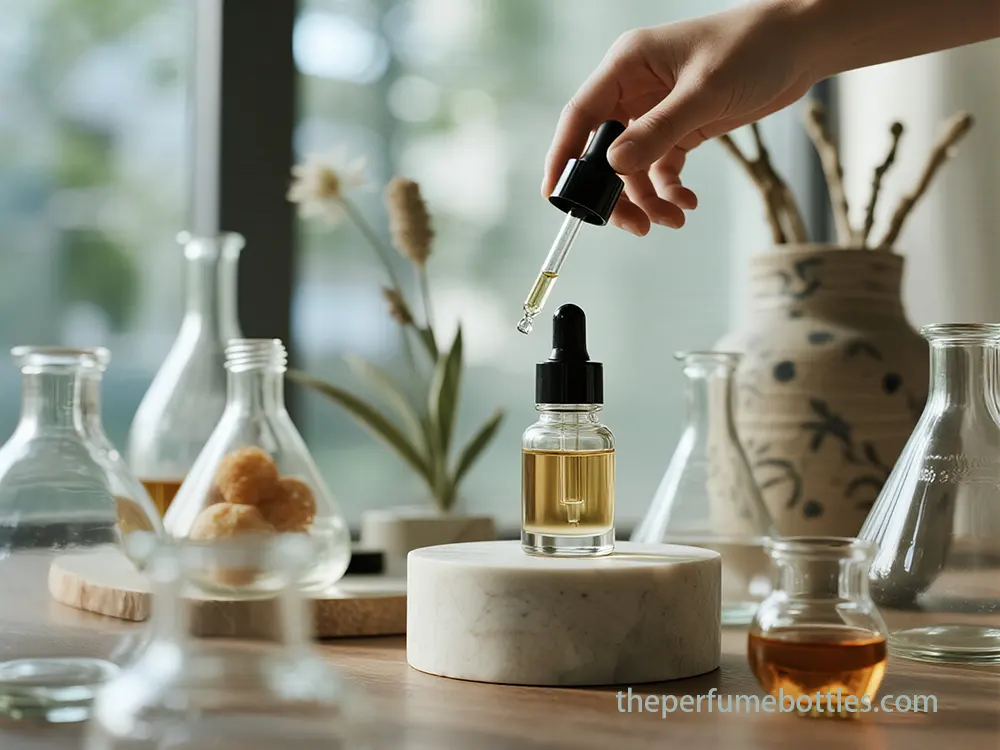
무료 샘플 받기
7. 전략적 파트너십: 시장 출시 속도 가속화 및 비용 효율성 향상
포장 회사는 전략적 자문 역할을 하며, 시장 동향을 권고하고, 비용에 적응하며, 효율적인 에센셜 오일 제품 출시를 위해 신속하고 효율적으로 긴축 생산을 적용합니다.
7.1. 시장 동향 및 정보
에센셜 오일 산업은 성인의 68.7%가 정기적으로 에센셜 오일을 사용하는 주류 복지 산업입니다. 이 시장은 자연 건강, 영원한 삶, 그리고 전반적인 웰빙에 대한 소비자들의 선호에 힘입어 상당한 성장세를 보일 것으로 예상됩니다. 포장 트렌드는 친환경 소재와 미니멀한 디자인을 통해 개인화와 안정성을 강조합니다.
7.2. 전략 컨설턴트로서의 포장 회사
패키징 회사는 제조 이상의 부가가치 서비스를 제공합니다. 시장 동향을 분석하고, 비용 구조를 최적화하며, 민첩한 생산 방식을 적용합니다. 패키징은 브랜드 정체성 확립, 가치 전달, 스토리텔링에 중요한 역할을 합니다. 특히 매력적인 패키징은 QR 코드나 AR 기능을 위한 인터랙티브 요소를 통합하는 강력한 소셜 미디어 마케팅 도구 역할을 합니다. 이러한 참여는 마케팅 자료에 대한 데이터/뷰를 제공합니다.
7.3. 비용 최적화 방법론
- 가치공학(VE) 및 가치분석 및 가치공학(VAVE): 효율적인 재료 사용, 구조 설계 적용, 재료 재구축, 2차 포장 등의 체계적인 접근 방식을 통해 품질이나 기능을 저하시키지 않고도 제품 비용을 절감(일반적으로 5~40%)할 수 있습니다.
- 간접 비용 절감: 보관 공간이 적고, 가벼운 소재로 운송 비용이 낮으며, 포장 시간도 가장 짧습니다.
- 강화된 포장 강도: VE는 포장의 강도를 높여 운송 중 손상을 줄여 고장 발생률을 낮추고 비용을 크게 절감할 수 있습니다.
- 전문화 및 데이터: 포장 엔지니어는 데이터와 독점 모델을 사용하여 이상적인 재료를 식별하고, SKU를 표준화하고, 운영을 간소화하여 8~16%의 비용 절감 효과를 보고합니다.
- 재설계 및 최적화: 포장 재배치와 형태 최적화를 통해 내용물의 부족과 폐기물의 부족을 해소할 수 있습니다. 병의 무게를 8% 줄이면 매년 약 160만 톤의 내용물을 제거할 수 있으며, 30억 달러 이상을 절약할 수 있습니다.
7.4. Agile 생산 방법론 및 시장 출시 속도
- 린 제조: 공급망을 간소화하여 낭비를 없애고, 지속적이고 책임감 있는 흐름을 구축하며, 최소 비용으로 최소 수요를 충족하는 제품을 생산합니다. 이를 통해 원활한 출시, 품질 향상, 그리고 거의 완전히 제거될 수 있었습니다.
- 1분 교환 다이(smed): 린 기능의 린 기능, 외부 기능, 간소화된 활동, 분리, 분리, 개별 활동을 줄이기 위한 린 기능.
- 구현 이점: SMED를 적용하고 MES/CMM을 통합하면 평균 변경 시간을 3개월 이내에 20~30%, 6~12개월 이내에 40~50% 단축할 수 있습니다. 사례 연구에 따르면 연구 기간이 크게 단축되어 전체 장비 효율(OE)이 향상되고 인건비가 절감되는 것으로 나타났습니다.
7.5. 전략적 패키징 파트너십의 투자 수익률
전략적 파트너십 서비스(Prasad)는 다각화, 신규 시장 진출, 자원 적응, 그리고 창의성/혁신 증진을 지원합니다. ROI 측정은 수익성과 정보에 기반한 의사 결정에 중요하며, 직접 비용과 간접 비용을 모두 고려합니다. 정기적인 평가 및 평균 목표 달성을 통해 ROI를 추적하고 전략적 목표와의 일치성을 보장합니다. 탄탄한 제조 파트너십은 공급망 투명성, 낮은 중단 시간, 신속한 납품, 공유 가치, 그리고 엄격한 품질 보증을 통해 고품질 제품을 생산합니다.
7.6. 시장 수요 예측에서 데이터 분석의 역할
수요 예측에 사용되는 데이터 분석은 과거 데이터, AI 알고리즘, 통계 모델, 그리고 실시간 인사이트(POS, 온라인 거래)를 바탕으로 정확한 생산, 재고 및 판매 결정을 내릴 수 있도록 지원합니다. 과잉 생산을 줄여줍니다. 포장 회사의 경우, 정확한 예측을 위해서는 정량적 분석(예: 시계열 분석)과 정성적 분석(전문가 의견)을 결합하는 것이 필수적입니다.
8. 유리 에센셜 오일 포장의 새로운 혁신
에센셜 오일 병의 디자인과 기능의 미래는 미래 지향적인 트렌드와 기술 진보에 따라 형성됩니다.
8.1. 향상된 보호 및 기능성을 위한 고급 표면 처리
- 맞춤형 UV 보호: 앰버 유리 블록은 UVB 광선을 98% 차단합니다. 원자층 증착(ALD)과 같은 첨단 기술을 사용하여 투명도를 손상시키지 않으면서 자외선 차단 파장을 정확하게 조절하여 정교한 광감응 방지 기능을 제공합니다.
- 에센셜 오일 기반 항균 코팅: 에센셜 오일은 항균 특성을 가지고 있습니다. Clear Research(2024년 8월)는 마이크로나노스피어 내에 유칼립투스 에센셜 오일을 포함하는 새로운 항균 표면을 개발했습니다. 이 표면은 오염을 99.98% 감소시켜 바이오필름 형성을 예방할 수 있는 가능성을 보여주었습니다.
- 소수성 및 유성 코팅: 이러한 코팅은 내유성, 내지문성, 내수성이 뛰어난 표면을 형성하여 가전제품에 널리 사용됩니다.
- 플라즈마 이온 교환 치료(P-IET): 시너지 효과가 있는 P-IET 공정 유형 I 붕규산 유리는 지속 가능한 친수성 표면을 만들어냅니다. 이는 물 기반 약물을 효율적이고 낭비 없이 분배하는 데 중요하며, 정확하고 정밀한 복용량에 맞게 조정할 수 있습니다.
8.2. 향상된 소비자 참여 및 공급망 보안을 위한 스마트 패키징 통합
진위성 및 추적성을 위해 NFC/RFID: 현장 통신(NFC)과 무선 주파수 식별(RFID)은 고부가가치 분야에서 제품 인증 및 공급망 추적을 위해 사용됩니다. 카운터 및 동적 암호화 알고리즘도 사용됩니다.
- 소비자 경험 역량: 스마트 패키징(QR 코드, NFC 태그, AR)은 자세한 제품 정보, 사용 지침 및 복용량 알림을 제공하고, 고객과 긴밀하게 상호 작용하며, 개봉 경험을 향상시킵니다.
- 윤리적 의미: AI 기반 스마트 패키징 데이터는 개인정보 보호, 보안, 공정성, 책임성에 대한 중요한 도덕적 관점을 제시합니다. 민감한 정보의 수집, 사용 및 저장은 매우 중요합니다.
8.3. 새로운 지속 가능한 유리 제형 및 환경 고려 사항
- 생분해성 유리: 2023년 3월, 아미노산과 펩타이드를 기반으로 한 친환경 유리 제품군이 새롭게 출시되었습니다. 이 제품은 재활용 및 생분해가 가능한 바이오 기반 유리로, 기존 유리의 비생분해성 문제를 해결했습니다. 그러나 현재 "대량 상용화와는 거리가 멉니다".
- 초경량 유리: 50년 이상 동안 유리 포장재를 생산하는 데 필요한 에너지는 30%, 무게는 70% 감소했습니다.
- 영구적인 옵션으로서의 유리: 유리는 100% 재활용되며 품질 저하 없이 무한정 재활용할 수 있습니다. 재활용은 에너지 소비와 이산화탄소 배출량을 줄입니다. 소비자들은 환경 친화적이라는 이유로 유리 포장재를 선택합니다.
- 친환경적 폐쇄 및 리필 시스템: 혁신에는 생분해성 캡, 대나무 뚜껑, 재활용 PP 드로퍼가 포함됩니다. 일회용 포장재를 줄이기 위한 재활용 및 재사용 솔루션이 주목을 받고 있습니다.
베셀럭스는 이러한 혁신의 선두에 서서 최첨단 기술과 지속 가능한 관행을 결합한 맞춤형 솔루션을 제공하여 필수 오일을 보호하고 보존할 뿐만 아니라 브랜드의 존재감을 강화하고 현명한 소비자에게 공감을 얻는 포장을 제공합니다.
댓글
제품 카테고리
인기 세일 병
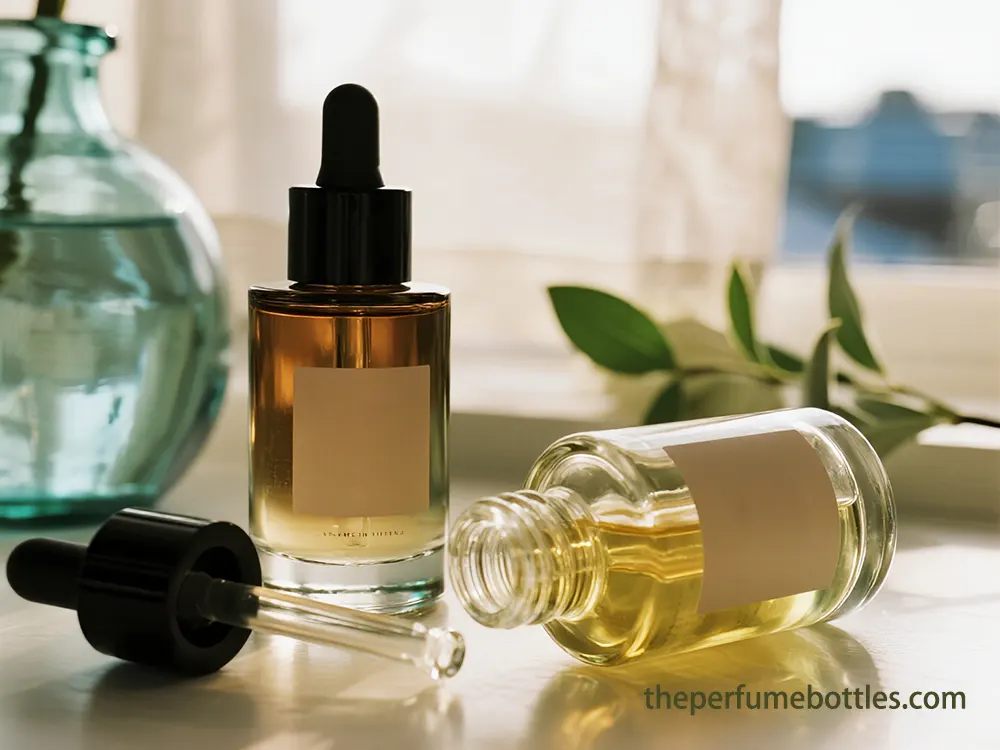
적합한 유리 스포이드 병 공급업체를 선택하는 방법: 가격보다 중요한 이유
비용뿐 아니라 품질, 규정 준수, 공급 안정성 및 지속 가능성에 중점을 두어 적합한 유리 스포이드 병 공급업체를 선택하는 방법을 알아보세요.
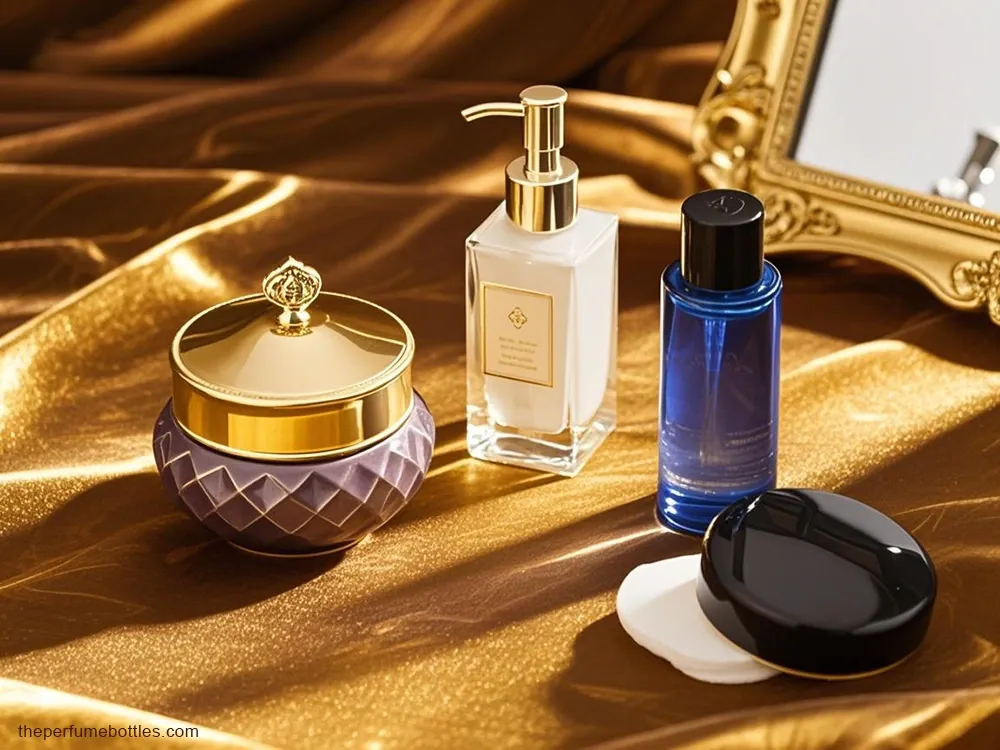
브랜드에 맞는 화장품 포장 공급업체를 선택하는 방법
미적 화장품 포장 공급업체를 선택하는 것은 전략적으로 필수적이며, 브랜드 정체성, 소비자 인식, 투자 결정에 영향을 미칩니다.
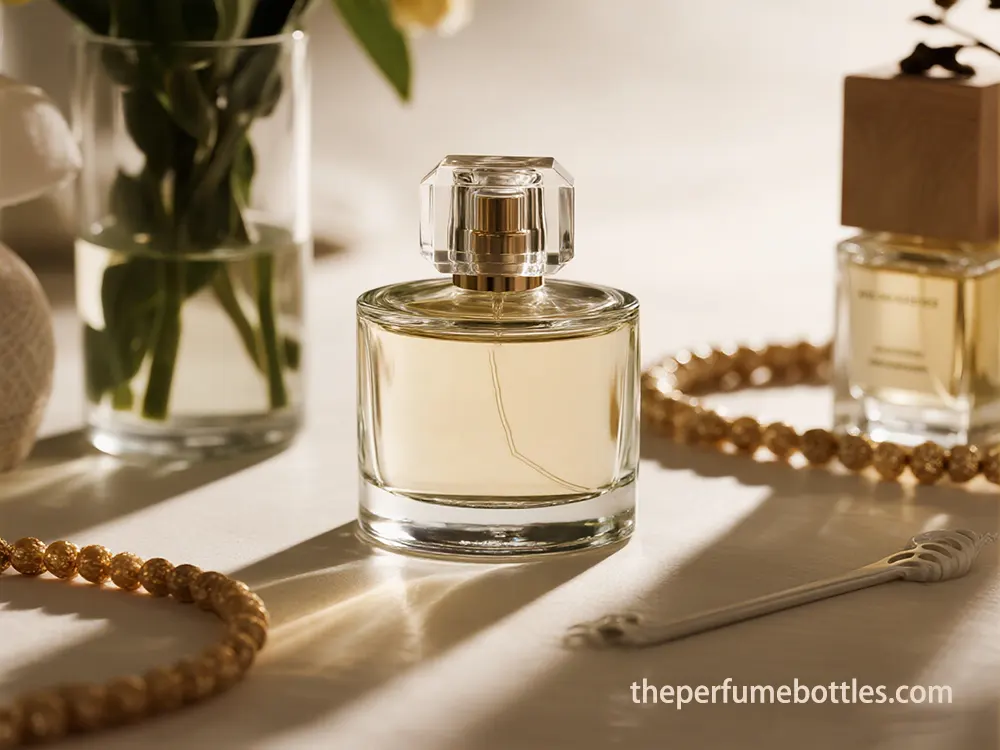
유리 향수병 공급업체 선택을 위한 전략적 프레임워크
향수 브랜드의 속도와 확장 가능한 성장을 촉진하는 올바른 파트너가 어떻게 필요한지 보여주는 이 가이드를 통해 전략적 유리 향수병 공급업체를 찾아보세요.
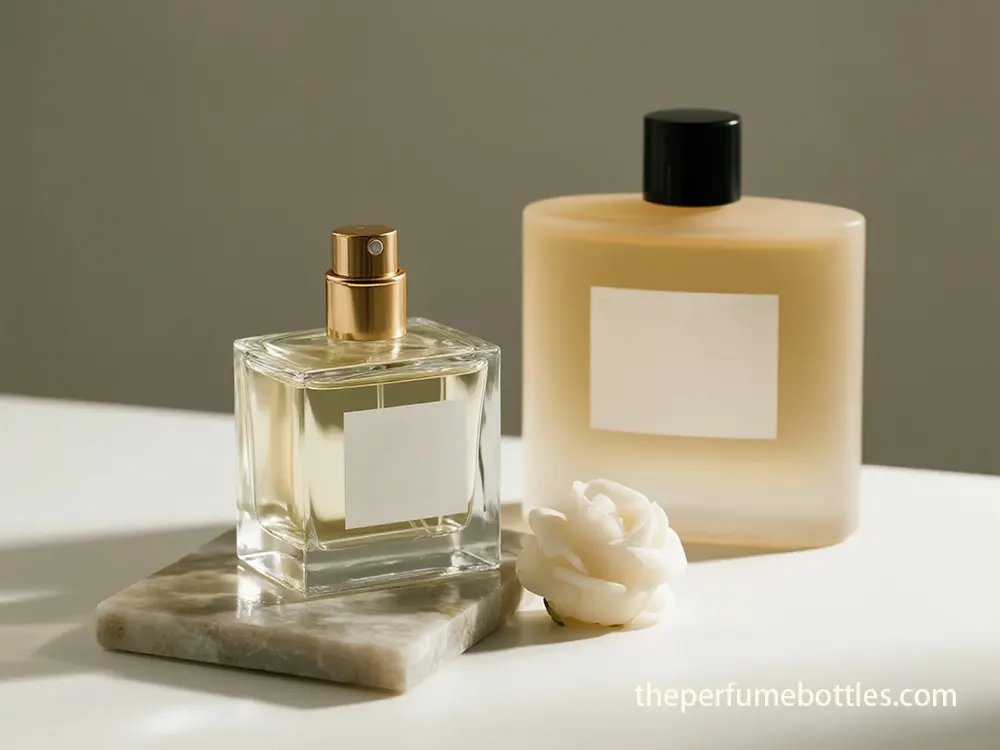

- +86 186 5178 1159
- [email protected]
- 월-일 07:00-21:00
태그

적합한 유리 스포이드 병 공급업체를 선택하는 방법: 가격보다 중요한 이유
비용뿐 아니라 품질, 규정 준수, 공급 안정성 및 지속 가능성에 중점을 두어 적합한 유리 스포이드 병 공급업체를 선택하는 방법을 알아보세요.

사례 연구: 포르투갈의 한 독립 향수 브랜드가 Mosteb을 유리 향수병 공급업체로 선정한 과정
한 향수 브랜드는 당사와 유리 향수병 공급업체로서 협력하여 정밀한 엔지니어링과 안정적인 맞춤 생산을 통해 병 표면의 성에 발생 및 뚜껑 밀착 문제를 해결하고 있습니다.

유리 향수병 공급업체 선택을 위한 전략적 프레임워크
향수 브랜드의 속도와 확장 가능한 성장을 촉진하는 올바른 파트너가 어떻게 필요한지 보여주는 이 가이드를 통해 전략적 유리 향수병 공급업체를 찾아보세요.

사례 연구: 당사 유리 롤러 병 공장에서 에센셜 오일 브랜드에 포장재 제공
유리 롤러 병 공장이 어떻게 롤링 안정성과 얇은 목 내구성 문제를 해결하여 안정적이고 누출 없는 프리미엄 병을 공급하는지에 대한 사례 연구입니다.

